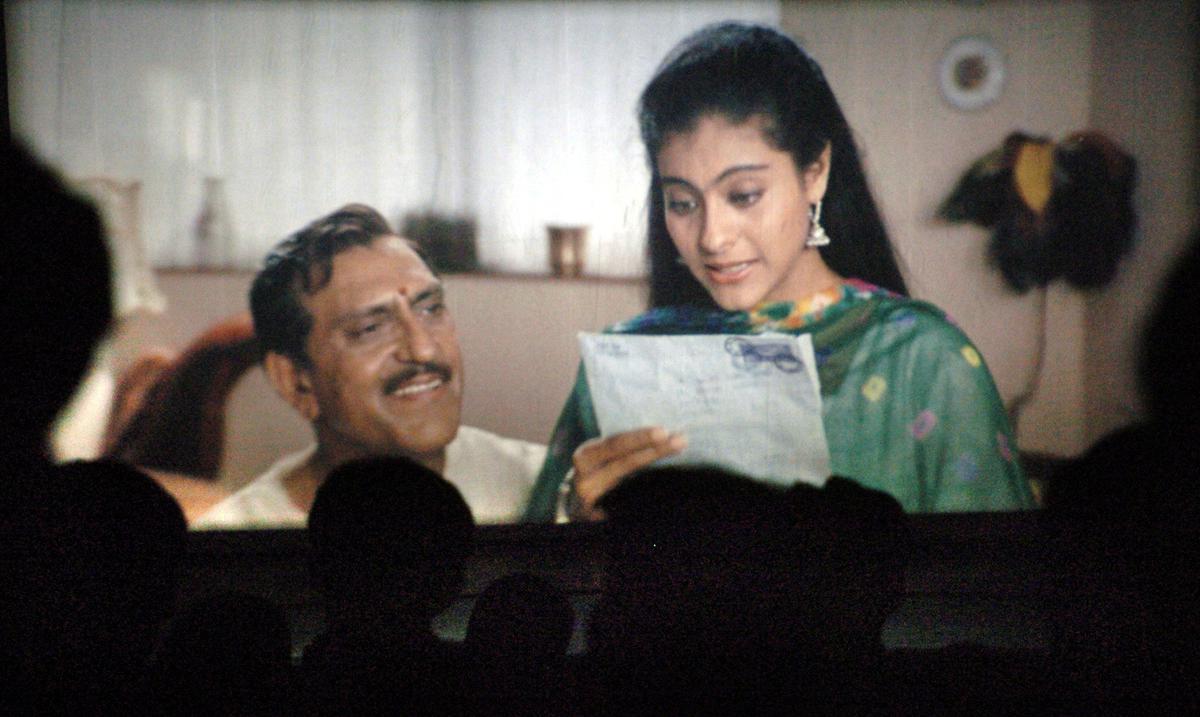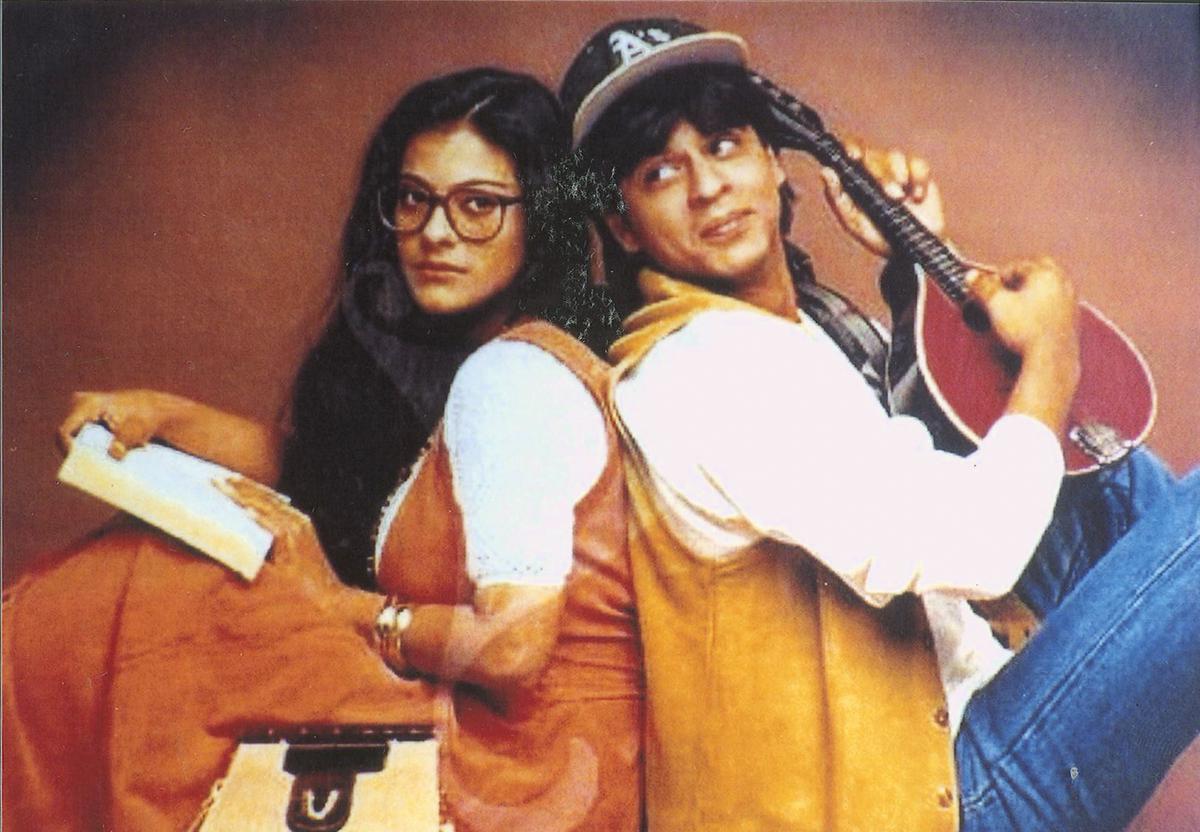Dilwale Dulhaniya Le Jayenge (1995)
Director: Aditya Chopra
Cast: Shah Rukh Khan, Kajol, Amrish Puri, Farida Jalal, Anupam Kher
Music: Jatin Lalit
American critic Charles Taylor in his review of Dilwale Dulhaniya Le Jayenge (DDLJ) sums up his experience of the film as “a flawed, contradictory movie — aggressive and tender, stiff and graceful, clichéd and fresh, sophisticated and naive, traditional and modern…” He, however, admits, “It also, I think, is a classic!” That the 1990s cult film,is now considered a contemporary classic is a fact. Its subsequent socio-cultural impact, however, far outweighs its cinematic worth.
DDLJ’s success pioneered a new genre, NRI, in Indian cinema which in the decade and half since, has emerged as a prime determinant in the success and circulation of Hindi cinema in the West (especially the U.K. and the U.S.). Though director Manoj Kumar had tackled this issue for the first time in Purab Aur Paschim (1970), his hero, Bharat, however, was an Indian who goes to the U.K., where he ‘Indianises’ the film’s British Indian heroine. In DDLJ, not only the protagonists, but also their immediate family members are all British citizens.

Amrish Puri and Kajol in a scene from Dilwale Dulhania Le Jayenge
| Photo Credit: INDRANIL MUKHERJEE
However, coming back to Charles’s observation, what’s interesting to note are his adjectives that refer to some of the navarasas — aggressive (veera), tender (karuna), stiff (raudra), graceful (shringara), perhaps without a recognition of the working of the same in Indian film narratives.
The plot
Raj Malhotra (Shah Rukh Khan) and Simran Singh (Kajol) are two young non-resident Indians, living in London, who fall in love during a vacation in Europe. However, Simran’s father, Chaudhry Baldev Singh (Amrish Puri), has promised his childhood friend to get Simran married to the latter’s son.

From ‘Dilwale Dulhania Le Jayenge.
| Photo Credit: The Hindu Archives
When Baldev comes to know of Simran’s relationship with Raj, he hurriedly makes arrangement for her marriage.On the other hand, encouraged by his father Dharamvir Malhotra (Anupam Kher), Raj follows Simran to India, not to rescue or elope with her, but to win over Simran’s family. In essence, the film is an obvious narrative evoking the love or shringara rasa. Traditionally, it would have been defined as an epic romantic melodrama given its scale and length. In contemporary terms, its structure is more like a romantic comedy for the strong undercurrent of fun and humour that defines and develops the love story.
Anupam Kher and Shah Rukh Khan in Dilwale Dulhaniya Le Jayenge.
| Photo Credit: The Hindu Archives
Given the nature of the development of events against two distinct backdrops — Europe and Punjab — DDLJ almost unveils like two separate films. While the first half is in the usual boy-meets-girl format, the second half, however, opts for a more subtle, serious and uncommon denouement of their love saga, nurtured by an undercurrent of empathy or karuna. While the protagonists share mutual concern for their individual efforts to fight the rising odds to their love, the audience too is conditioned to re-view the story from a more concerned and empathetic perspective.
Love may be the uniting emotion in the film and its songs, but DDLJ is not just about romance.
From Dilwale Dulhaniya Le Jayenge.
| Photo Credit: The Hindu Archives
Baldev Singh’s life in London is sustained by an abiding love for his motherland, India. The impact is heightened by the film’s theme song, ‘Ghar aaja pardesi…’ (Come home, O wanderer!), which lends voice to Baldev’s unspoken longing for his homeland, Punjab.
Mother’s crucial role
Vatsalya (mother’s affection) defines the relationship between Lajwanti ‘Lajo’ Singh (Farida Jalal) and her elder daughter Simran. It is the empathy, born out of this love, that makes Lajwanti resolve to ask Simran and Raj to flee when she discovers their love.
A humourous romantic sequence between Dharamvir and Simran’s unmarried aunt Kammo (Himani Shivpuri) is used occasionally as a comic relief to lighten up the film’s tense moments (pathos, fear and anger) in the second half. Though it preaches about morals, tradition and family values, it was in a way a coming-of-age film, where the young finally are allowed to live their dreams.
Indian filmmakers have often been influenced by our epics to come up with larger-than-life heroes and characters that win in tough circumstances. Like art and mythology, diverse rasas drive our films too.
The critic, author, filmmaker is Dean, School of Liberal Arts and Sciences, RV University, Bengaluru.
Stay connected with us on social media platform for instant update click here to join our Twitter, & Facebook
We are now on Telegram. Click here to join our channel (@TechiUpdate) and stay updated with the latest Technology headlines.
For all the latest Entertainment News Click Here
For the latest news and updates, follow us on Google News.
